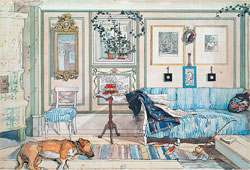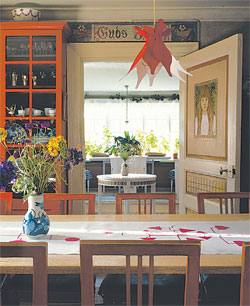Interiors: the trend for Gustavian
Simply sign up to the Life & Arts myFT Digest -- delivered directly to your inbox.
Open any interiors magazine, on practically any continent, and you will see pages of beautiful, white rooms filled with pale furniture on lime-washed floorboards, accessorised with huge mirrors and topped off with a crystal chandelier. You might think this is a just a modern fad but, in fact, it dates back to the 1780s when it was the style of decor used in the Swedish royal palaces.
Gustavian style, as it is properly known, was brought to Sweden by King Gustav III following a visit to the Palace of Versailles, where he was so impressed by what he saw that, upon returning home, he decided to create his own “Paris of the North”.
Sweden was, at that time, a major European force. The country was rich from its stocks of iron ore and timber and, although not on a par with France or Russia, it was certainly able to compete with the grand royal houses of both countries.
Gustav III was a patron of the arts, founder of the Swedish Academy and commissioner of the Royal Opera House. Since his death in 1792 – from a gunshot wound sustained at a masked ball – the king has become synonymous with a style of furniture that is known throughout the world.
It is a pared back version of French neoclassicism. The legs on tables, chairs and sofas are usually carved with scallop detailing, often with a rosette at the top. Large mirrors, which maximised the light during long winters, were gilded, while chandeliers tended to have five or seven arms with candleholders. Additional light was provided by candles in wall sconces. The style spread from the royal palaces of Drottningholm and Gripsholm to the town houses of the well-to-do and out to their country cottages, where it became more rustic and homespun but was still recognisably Gustavian in its origins.
Provincial Gustavian, or Swedish country style, as it is sometimes known, was popularised by the artist Carl Larsson (1853-1919), whose wife Karin decorated their timber cottage, Lilla Hyttnäs, near Falun, central Sweden, which he used as the backdrop for many of his paintings.

Where the wealthy used pale blues and whites and delicate gilt flourishes in their homes, the Larssons brought in deeper shades of ochre, darker blues and rich earthy reds. Silk damask hangings were replaced by linen and chandeliers with simple wooden wall sconces. There was often a long case clock, known as a Mora, named after the town where they were first made. It was all much less formal than its city cousin.
Today, with Gustavian very much back in vogue, original pieces dating from the 18th century can fetch thousands of dollars at auction. Just a few weeks ago a chest of drawers sold at a Swedish auction house for the equivalent of $46,000. Made by Nils Johan Asplind during the 1780s, the reserve price had been set at less than half that at SKr125,000 ($18,750)
Daniel Larsson (no relation to Carl), an antiques dealer in Helsingborg, says that although the style remains very popular on the international market, buyers have become more discerning in recent years.

“The days of US helicopters flying over, loading up with furniture and taking off again are gone,” he says.
Larsson is keen to make a distinction. “Gustavian is of the period whereas ‘Gustavian-style’ is later, perhaps 19th century, and, while still popular, doesn’t sell for quite as much as the original pieces, which need special export licences before they can leave Sweden,” he says.
This does not worry Toby Lorford, an antiques dealer in Tetbury, Gloucestershire, who started selling Gustavian furniture 12 years ago. “In that time the prices have doubled and doubled again,” he says. “It’s the one style of furniture that has held its price since the crash and I think it will continue to do so.
“It’s such a perfect combination of Swedish restraint and the French decorative style which makes it calm and easy to live with. It is timeless and unfussy and works just as well in a Manhattan penthouse as it does in a London townhouse or country estate.”
Chantal Coady, founder of Rococo Chocolates, was so inspired by the look following a visit to Stockholm, that it has become her signature style. Her four shops are painted in a combination of Farrow & Ball Hague Blue and Citron yellow, both of which closely resemble the earthiness of the original style. “The colours work so well in our European light. The whole palette has a little bit of grey so they look great with the gilt that was often used alongside,” she says. “It’s very calming and so timeless and it covers the whole spectrum from rustic to incredibly grand.”
Coady also owns a limited edition Gustavian-inspired sofa which she bought from Ikea 16 years ago for £1,000. “It’s the most well-made piece and I still really love it but they have never repeated it.”

That was not the first time the Swedish superstore has borrowed from its Gustavian heritage, according to the official website of the Royal House of Norway – in the mid-1950s, Ikea made copies of a commode by Georg Haupt that belongs to Stockholm’s Nordiska museet (Nordic Museum).
Haupt was the third generation of court cabinetmakers and is considered instrumental in the establishment of Gustavian style. The Royal Collections in Stockholm has about 30 of his pieces and last month a decorated commode by Haupt sold for SKr6.5m at the Stockholm auction company Bukowskis. In 1989, one of his commodes fetched a record-breaking SKr12.2m.
But it is impossible to talk about this style without mentioning shabby chic. The fashion for painted, slightly distressed furniture may have come from Gustavian (or French) origins but is a poor copy. Joe Lee, of Swedish Interior Design whose half-Swedish wife, Madeleine, has decorated their Brighton home in this classic style and who is one of the most respected dealers in the field, says it has now become descriptive of a look rather than a period.
“True Gustavian dates from about 1780 to 1810 although it had a resurgence every 25 years until the 1920s and each time it was slightly changed,” he says. “But that pale grey that everyone associates with it was never used and is merely a modern marketing tool that is more associated with shabby chic. There is a lot of expensive reproduction about. The original paint was often handmade and not great quality and it was also very hard to produce a perfect white, so the idea has grown up that Gustavian style used grey but that’s not true.”
Tania Urban (www.ellaandotto.com), a Swedish textile designer living in London, has a typical red summer cottage in Sweden. The red paint was a byproduct of the iron ore mines and is found all over the country.
“Our little red Stuga in southern Sweden is light and airy with white furniture, whitewashed wooden floors and hand-embroidered linen covers sewn by my maternal grandmother. There are decorative curtains and an ornamental glass chandelier, which holds candles, as well as a grandfather clock in the corner,” she says.
Urban has tried to incorporate some of that look into her Victorian home in London as well.
“We have floorboards and a peasant sofa in the kitchen as well as painted wooden chairs which are often part of Scandinavian country houses. Simple but decorative linen sackcloth pillows furnish the seating area and the white, light grey colour scheme together with the glass chandelier gives the kitchen living area an understated grandness reflective of the period.”
Comments